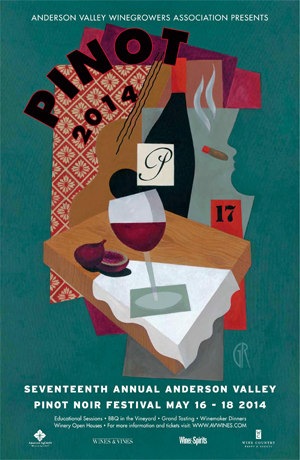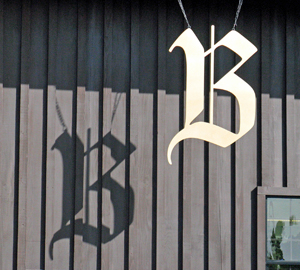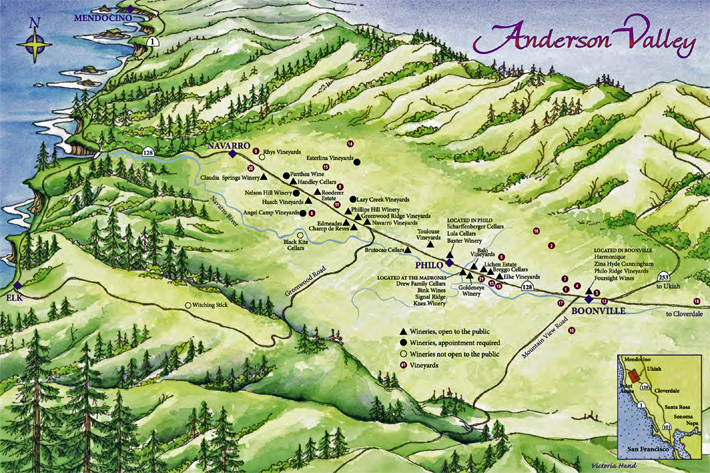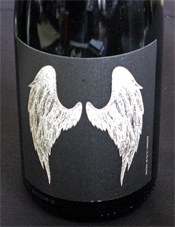Angel Camp Vineyards
Angel Camp 2013 Pinot Noir Blanc, Anderson Valley. Picked early and whole-cluster pressed with no skin contact, made in neutral oak and aged on the lees. Light straw color, with stone fruit and fresh herbs on the nose. Medium-light bodied with juicy acidity and a clean, fresh finish, nice.
Angel Camp 2012 Pinot Noir, Anderson Valley. From 677, David Bruce, Martini, Pommard, and Swan clones, aged in 40% new French oak. Medium-light ruby color, this had herbal and mushroom/earth aromas upfront, with strawberry and tea leaf in support. Medium-light weight with moderate acidity and a savory note on the finish along with milder tannins, very tasty and a good choice for earlier drinking.
Comments: 2011 marked the first vintage for the Angel Camp label. Angel Camp Vineyard, in the “deep end” of the valley, was planted in 2006 and has become the source for some fine Pinots from other producers as well. Angel Camp continues to be a new label to watch.
Ardzrooni Family Wines
Ardzronni 2012 Pinot Noir, “Genevieve’s Blend,” Anderson Valley. Sourced from Ferrington Vineyard, fermented with some whole clusters and aged in 20% new oak. Lighter ruby color, with black cherry, spice, and a touch of sweet oak on the nose. Medium-light bodied with a bright texture and fairly mild tannins.
Comments: This is the first release by a new label from the family of Paul Ardzrooni, who manages many of Anderson Valley’s most highly-regarded vineyards. Paul’s daughter Genni is the winemaker, and the wines are made at the Schramsberg facility.
Avenging Angel Wines
Avenging Angel 2012 Pinot Noir, Anderson Valley. Sourced from 50% each Angel Camp and Balo vineyards, with 667, 777, 2A, Pommard, and Swan clones, fermented with 50% whole clusters and aged in 15% new French oak. Medium-light color, featuring red fruits, fresh herbs, earth and forest floor on the nose. Medium-light bodied with a bright mouthfeel, refined tannins, and long finish, nice.
Comments: This was the first vintage for this wine, a joint project of Angel Camp and Balo dedicated to the memory of a friend and a family member. This was a fine effort and one of the standouts of the tasting.
Balo Vineyards
Balo 2013 Pinot Noir Blanc, Anderson Valley. Whole-cluster pressed immediately with no skin-juice contact, and made in 75% stainless steel and 25% neutral oak. Light straw color, this showed pear and apple fruit along with a hint of flowers. Medium-light weight on the palate with a lively texture and crisp finish.
Balo 2013 Vin Gris of Pinot Noir, Anderson Valley. Very light salmon/pink color, with strawberry, spice, and earth aromas. Medium-light bodied with juicy acidity and a bright finish, nice.
Balo 2012 Pinot Noir, Estate, Anderson Valley. From 777, 115, Pommard, and Martini clones, fermented with 30% whole clusters and aged in 30% new French oak. Medium-light ruby, this showed black cherry fruit along with herbal, brushy notes and hints of flowers. Medium-light bodied, with good acidity and moderate tannins – nice now and worthy of a few years in the cellar as well.
Balo 2012 Pinot Noir, “Suitcase 828,” Estate, Anderson Valley. From the “suitcase” version of the 828 clone (likely not true 828). Medium-light color, displaying strawberry, herbs, earth, and a savory note. Medium-bodied with a lively mouthfeel, good structure, and moderate tannins.
Comments: Balo was founded in 2009 by growers Tim and Michele Mullins, and the wines are made by Jason Drew. The estate Balo Vineyard is in the Philo area and was first planted in 1998. It’s farmed organically, though not yet certified. The “Suitcase 828” bottling is Balo’s first single-clone Pinot. All of these wines were very good.
Baxter Winery
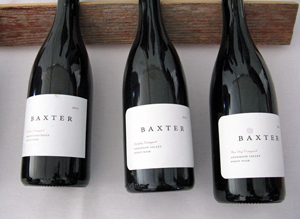 |
Baxter 2010 Pinot Noir, Anderson Valley. Sourced from a number of vineyards. Lighter color, with red fruits, tea leaf, and a floral touch. Medium-bodied with lively acidity and milder tannins – good for early drinking.
Baxter 2011 Pinot Noir, Valenti Vineyard, Mendocino Ridge. Fermented with 30% whole clusters. Light color, this featured a more savory and herbal profile, along with strawberry and cranberry fruit, forest floor, and floral notes. Medium-light weight on the palate, this had a vibrant mouthfeel and moderate tannins, very nice now and should continue to develop well in the bottle.
Baxter 2012 Pinot Noir, Langley Vineyard, Anderson Valley. Made entirely from Roederer clone 32 vines planted in 1982, aged in neutral French oak. Medium-light color, displaying raspberry, earth, baking spice, and flowers on the nose. Medium weight on the palate, this was lively and structured with moderately chalky, grippy tannins on the finish – nice now but should age well.
Baxter 2012 Pinot Noir, Run Dog Vineyard, Anderson Valley. From Pommard clone vines grown at a one-acre site. Lighter color, this showed riper and more forward fruit, with black cherry, spice, and tea leaf notes. Richer mouthfeel with plenty of structure and a firm tannic finish.
Baxter 2012 Pinot Noir, “Whole Cluster,” Oppenlander Vineyard, Mendocino County. To be released this fall, this is a small bottling made with later-picked Pommard, 114, and 115 clones, fermented using 100% whole clusters and carbonic maceration. Medium-light color, with herbal/stemmy aromas upfront, followed by black cherry, forest floor, and tea leaf notes. Medium-bodied and structured to age, with a grippy tannic finish – an intriguing wine that will take some time to develop.
Comments: I continue to be impressed by the Baxter wines. Both Phil Baxter and his son Phillip were on hand at the event. Both father and son studied winemaking (at Cal State Fresno and UC Davis, respectively), and have long backgrounds in the wine business. The Baxter label was launched in 2002. Fruit is typically 100% destemmed except for the Valenti bottling, then undergoes native yeast fermentations, and is aged in neutral oak. Baxter presented a solid line-up of wines again this year.
Bink Wines
Bink 2012 Pinot Noir, Anderson Valley. From four clones, mostly sourced from Thomas T Thomas Vineyard. Medium-light color, showing black cherry, earth, and forest floor aromas. Medium-bodied with good structure, finishing with firm but refined tannins, nice.
Bink 2012 Pinot Noir, Thomas T Thomas Vineyard, Anderson Valley. Lighter color, this featured red fruits, spice, and sweet oak on the nose. Medium weight in the mouth with a fairly grippy tannic finish, this could use time in the cellar.
Comments: Bink was founded in 2003 by Cindy Paulson and winemaker Deb Schatzlein, who was behind the table pouring her wines. Bink owns noted Hawks Butte Vineyard in the Yorkville Highlands just southeast of Anderson Valley. Thomas T Thomas Vineyard is located adjacent to Toulouse Vineyard near Philo.
Brutocao Family Vineyards
Brutocao 2011 Pinot Noir, Anderson Valley. From 113, 115, 667, 777, Pommard, and Swan clones, aged in 30% new French oak. Lighter garnet color, displaying higher-toned red fruits along with lots of spice and a resiny oak note. Medium-bodied, finishing with moderate tannins.
Comments: The Brutocao family released their first wine from the 1980 vintage, and they farm four separate vineyard sites in Mendocino County. Their vineyard in Philo, planted in 2001, is the source for their Pinot Noir.
Cakebread Cellars
Cakebread 2012 Pinot Noir, Two Creeks Vineyards, Anderson Valley. From Dijon, Pommard, and Swan clones, aged in 38% new French oak. Medium-light color, this had riper cherry fruit, spice, and vanilla/oak aromas. Medium weight on the palate, with a smoother texture and finish – a pleasant early drinker but not showing much Anderson Valley character.
Comments: Cakebread’s 46-acre estate vineyard in Anderson Valley was planted to six clones of Pinot Noir in 2001. They also purchased nearby Annahala Vineyard in 2011.
Champ de Rêves Vineyards
Champ de Rêves 2011 Pinot Noir, Anderson Valley. From 115, 667, and 777 clones, aged in 29% new French oak. Medium ruby color, this featured upfront black cherry fruit along with earth, spice, and sweet oak in support. Moderately rich mouthfeel, with medium tannins and a lingering finish – a good choice for drinking now.
Comments: A new label from Jackson Family Wines, Champ de Rêves – the winery name is French for “field of dreams” – focuses on Anderson Valley Pinot, sourcing their fruit from Boone Ridge Vineyard in the hills above Boonville. The vineyard site, formerly part of the Edmeades property, was planted in 2006 with seven Pinot clones, and the wines are made by Eric Johannsen.
Chanamé Wines
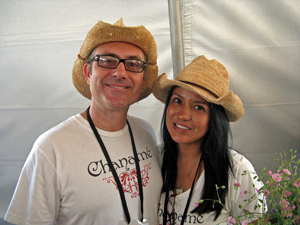 |
Chanamé 2012 Pinot Noir, Angel Camp & Charles Vineyards, Anderson Valley. From six Pinot clones, the fruit was entirely destemmed, and aged in 50% new French oak. Lighter color, with strawberry and rhubarb aromas along with forest floor notes and touches of spice and vanilla/oak. Medium-bodied with lively acidity and moderate tannins on the finish, nice.
Chanamé 2011 Pinot Noir, Anderson Valley. Sourced from several vineyards, the fruit was entirely destemmed, and aged in 50% new French oak. Medium-light color, this showed more herb, earth, and mushroom character than the previous wine, along with raspberry fruit. Medium weight on the palate, finishing with grippier tannins.
Comments: Chanamé is a new label, founded by the husband-and-wife team of James Hahn and Mila Chanamé. Their 2011 Pinot was their first vintage. They also produce Sauvignon Blanc, Chardonnay, and a Pinot Rosé. Both Pinots they poured were very good, and the 2012, sourced from two of Anderson Valley’s top vineyard sites, was a standout at the event.
Copain Wines
Copain 2011 Pinot Noir, Wentzel Vineyard, Anderson Valley. From a variety of Dijon clones planted on rocky sandstone soils. Medium-light color, this displayed raspberry fruit, earth, and fresh herbs on the nose. Medium-light bodied and lively on the palate, with moderately grippy tannins.
Copain 2011 Pinot Noir, “Kiser En Bas,” Anderson Valley. From the lower part of the vineyard on rocky clay soil, aged in 30% new French oak. Slightly darker color than the previous wine, with upfront black cherry, spice, and touches of tea leaf and black pepper. Medium-bodied and more structured than the previous wine, with firm tannins and a long pleasant finish.
Copain 2011 Pinot Noir, “Kiser En Haut,” Anderson Valley. From the upper part of the vineyard, on decomposed sandstone and shale soils, aged in 30% new French oak. Medium-light ruby color, this was less fruit-forward, with earth, forest floor, and a stony mineral note along with raspberry and spice. Medium weight on the palate, finishing with fairly big but refined tannins, nice.
Comments: Wells Guthrie established Copain in 1999. He’s been making Pinot Noir since the beginning, with nearly all the vineyard sources coming from Anderson Valley. Recent vintages have shown a lighter hand than the early ones. All of the Pinots get about 15-20% whole-cluster fermentation. Once again, Copain poured a find group of wines.
Davies Vineyards
Davies 2011 Pinot Noir, Ferrington Vineyard, Anderson Valley. From 115, 667, and 777 clones, aged in 33% new French oak. Medium-light color, with riper black cherry and plum, spice, and a resiny oak note. Medium weight and moderately rich on the palate, finishing with firm tannins.
Comments: The Davies family of Schramsberg Vineyards has had lots of experience with Pinot for their sparkling wines, and they released their first still Pinot Noir from the 2009 vintage. This wine was poured at the Ardzrooni Family Wines table.
Domaine Anderson
Domaine Anderson 2012 Pinot Noir, Anderson Valley. Aged in about 30% new French oak. Medium-light ruby color, this featured black cherry, plum, and dried herb aromas along with resiny oak overtones. Medium-bodied with moderate acidity, this had milder tannins on the finish.
Comments: The 2012 Pinot is part of Domaine Anderson’s inaugural vintage. Established by the Rouzaud family (Jean Claude Rouzaud is Chairman of Louis Roederer), Domaine Anderson acquired 50 acres of vineyards near Philo in 2011.
Donum Estate / Robert Stemmler Winery
Donum 2011 Pinot Noir, Estate, Anderson Valley. From seven Pinot clones sourced from Angel Camp Vineyard, aged in 54% new French oak. Medium-light color, with ripe black cherry fruit, herb and forest floor notes, spice, and lots of vanilla/oak on the nose. Moderately rich mouthfeel and structured for aging, with firm tannins.
Stemmler 2012 Pinot Noir, Estate, Anderson Valley. Sourced from Angel Camp Vineyard. Medium-light ruby color, this had herbal aromas, along with bright red fruits, earth, tea leaf, and spice. Medium-bodied with lively acidity, this finished with firm tannins – this should be very nice given some time in the cellar.
Comments: Donum Estate and sister label Robert Stemmler are well-known for their Carneros and Russian River Valley wines, and they now have a lease at Angel Camp Vineyard. The 2011 was the first Donum Anderson Valley Pinot while 2012 was the first from Stemmler. Dan Fishman is the winemaker and Kenneth Juhasz is the consulting winemaker for both labels.
Drew Family Cellars
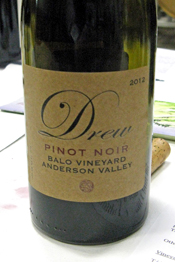 |
Drew 2013 Vin Gris, Anderson Valley. Sourced from Valenti Vineyard, direct press. Very light salmon color, displaying fresh strawberry and herb aromas along with hints of spice and flowers. Medium-light bodied with a crisp finish, nice.
Drew 2012 Pinot Noir, “Fog-Eater,” Anderson Valley. Sourced from 35% Akin, 30% Balo, 20% Morning Dew Ranch and 15% Wentzel vineyards, about 33% whole-cluster fermentation, aged in 15% new French oak. Medium-light color, this had herbal and earthy aromas upfront, along with black cherry, spice, and floral undertones. Medium-bodied and lively, with firm acidity and refined tannins, nice.
Drew 2012 Pinot Noir, Balo Vineyard Anderson Valley. From Pommard, 115, and 777 clones, 20% whole-cluster fermentation, aged in 33% new oak. Medium ruby color, showing intense black cherry fruit along with tea leaf, spice, earth, and a touch of sweet oak. Lively mouthfeel with good structure, fine tannins, and a long finish – nice now and should age well.
Comments: Jason Drew poured his wines at the tasting. Jason and his wife Molly moved both their wine focus and their family from Santa Barbara to Mendocino in 2005 – they’re located only about three miles from the ocean in the Mendocino Ridge AVA. They planted their own estate vineyard with eight clones of Pinot Noir in 2011. Drew continues to be one of Anderson Valley’s strongest producers.
Elke Vineyards
Mary Elke 2013 Rosé of Pinot Noir, Anderson Valley. Very light salmon/pink, with somewhat riper red fruit aromas along with floral notes. Medium-bodied with a fairly smooth texture and finish.
Elke 2011 Pinot Noir, Donnelly Creek Vineyard, Anderson Valley. From three Pinot clones, entirely destemmed and aged in 35% new French oak. Lighter garnet color, this displayed forest floor and mushroom aromas upfront, with red fruits and spice in support. Medium-light bodied, with the structure to age and moderate tannins on the finish – enjoyable now and has the potential to develop nicely.
Elke 2010 Pinot Noir, Donnelly Creek Vineyard, Anderson Valley. From three Pinot clones, entirely destemmed and aged in 35% new oak. Fairly light color, showing a riper and more fruit-forward profile, along with earth and a touch of sweet oak. Medium weight and a bit richer on the palate, with a grippier tannic finish.
Elke 2009 Pinot Noir, Donnelly Creek Vineyard, Anderson Valley. Completely destemmed, aged in 35% new oak. Slightly darker color, with upfront black cherry and spice on the nose, plus notes of tea leaf and vanilla/oak. Moderately rich mouthfeel with firm tannins.
Elke 2007 Pinot Noir, Donnelly Creek Vineyard, Anderson Valley. Completely destemmed, aged in 35% new oak. Lighter garnet color, this was less fruit-forward, displaying earth and forest floor aromas with red fruits and spice in the background. Medium-bodied with good structure and refined
tannins – this is developing very well.
Comments: The Mary Elke label Pinots are intended to be in a more “New World” style, while the Elke label Pinots (with the blue diamond) are more “Old World.” Mary Elke and her family farm their estate Donnelly Creek Vineyard, located just west of Boonville, planted in 1990 with five Pinot clones. The first wines under the Elke label were from the 1997 vintage, and Matt Evans has been the winemaker there since 2010.
Expression Vineyards
Expression 2011 Pinot Noir, “39°,” Ordway Vineyard, Anderson Valley. Medium color, this had a riper fruit profile along with lots of spice and vanilla/oak. Fairly big and structured on the palate, with more oak coming through on the tannic finish.
Comments: Ordway Vineyard (also known as Valley Foothill) is located near Philo. William Hill and Dick Wollack are the winery owners, and both Wollack and winemaker Patrick Mahaney have connections with Premier Pacific Vineyards – many sites that PPV developed are sources of Expression’s fruit. Each wine is named for the latitude of the vineyard site.
Ferrari-Carano Vineyards and Winery
Ferrari-Carano 2012 Pinot Noir, Middleridge Ranch, Anderson Valley. Aged in 48% new French oak. Medium-light color, showing oak and spice aromas upfront, followed by black cherry and a touch of earth. Medium-bodied with moderate tannins on the finish.
Comments: Ferrari-Carano was established in 1981 by Don and Rhonda Carano in Dry Creek Valley. Their Middleridge Ranch site is in the hills above Boonville. Sarah Quider is the label’s executive winemaker.
Foursight Wines
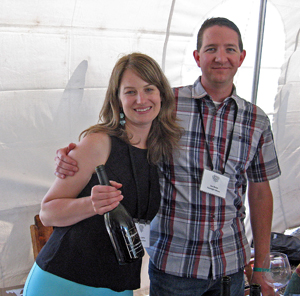 |
Foursight 2011 Pinot Noir, “Zero New Oak,” Charles Vineyard, Anderson Valley. From 114, 115, 777, and Pommard 5 clones, about 30% whole-cluster, all second-year and older barrels. Lighter ruby color, with bright red fruits, herbs, and floral notes on the nose. Medium weight on the palate with a lively mouthfeel and refined tannins, nice.
Foursight 2011 Pinot Noir, Charles Vineyard, Anderson Valley. Same clones as the previous wine, about 10% whole-cluster, aged in 40% new French oak. Light garnet color, showing strawberry and rhubarb aromas, spice, and a touch of sweet oak. Medium-bodied with bright acidity and moderate tannins.
Foursight 2011 Pinot Noir, “Clone 05,” Charles Vineyard, Anderson Valley. Entirely from Pommard 5 clone, about 30% whole-cluster, aged in 66% new French oak. Light garnet color, with strawberry and red cherry fruit, forest floor, and tea leaf aromas. Medium-light bodied with lively acidity and moderate tannins, quite pleasant.
Foursight 2010 Pinot Noir, Charles Vineyard, Anderson Valley. From 114, 115, 777, and Pommard 5 clones, about 30% whole-cluster, aged in 40% new French oak. Medium-light color, this had more upfront and ripe black cherry fruit, plus spice, tea leaf, and vanilla/oak notes. Medium-bodied with a richer mouthfeel, finishing with firm tannins.
Comments: Kristy Charles helped pour her family’s wines, which are sourced from their 15-acre estate vineyard near Boonville, planted in 2001. The Charles family first settled in Anderson Valley in 1943. Kristy and her husband Joe Webb founded Foursight along with Bill Charles and his wife Nancy in 2007. Joe makes the wines, and the Pinots all go through native primary and malolactic fermentation. A good line-up of wines from Foursight.
Frati Horn Wines
Frati Horn 2011 Pinot Noir, Anderson Valley. Sourced from Londer, Ridley, and Balo vineyards. Medium-light ruby color, this displayed bright cherry aromas plus earth, mushroom, and tea leaf notes. Medium-light weight in the mouth with lively acidity and moderate tannins – nice now but could benefit from more bottle age.
Frati Horn 2012 Pinot Noir, Anderson Valley. Sourced from Londer, Ridley, and Balo vineyards. Medium-light color, showing a riper fruit character than the previous wine as well as forest floor and herbs on the nose. A bit bigger on the palate with a smoother texture and refined tannins on the finish.
Comments: George and Anne Coughlin are the proprietors of Frati Horn (Boontling for “glass of wine”), in partnership with Jon Phillips of Inspiration Vineyards and Winery. 2009 was first vintage for the winery, and the early releases from Frati Horn have been solid efforts.
Fulcrum Wines
On Point 2011 Pinot Noir, “Christinna’s Cuvée,” Anderson Valley. From Pommard and Elliott clones (all from Donnelly Creek Vineyard), aged in 25% new Remond barrels. Medium-light ruby color, this featured floral aromas along with red fruits, earth, and a touch of vanilla/oak. Medium weight on the palate with lively acidity and a lingering finish, nice.
Comments: Fulcrum makes only Pinot Noir, and their first wines were from the 2006 vintage. They produce Pinots ranging from Anderson Valley to the Chalone appellation. The vineyard-designate wines are under the Fulcrum label while appellation wines are under the On Point label. David and Christinna Rossi are the winery proprietors.
Goldeneye Winery
Goldeneye 2011 Pinot Noir, Anderson Valley. Sourced from six vineyards, aged in 65% new oak and 35% second-year barrels. Medium-light color, this showed earth, black cherry, smoky oak on the nose. Medium-full bodied with plenty of structure and a firm tannic finish – needs time but could develop nicely.
Goldeneye 2011 Pinot Noir, Gowan Creek Vineyard, Estate, Anderson Valley. From a site planted to eight Pinot clones, aged in 65% new oak and 35% second-year barrels. Medium ruby color, with a bigger vanilla/oak component than the previous wine, along with black cherry, plum, and spice. Richer mouthfeel and structured for aging, finishing with moderately grippy tannins.
Comments: Founded by Dan and Margaret Duckhorn of Napa Valley Merlot fame, Goldeneye has been making Pinot Noir from Anderson Valley since 1997. They now farm four estate vineyards in the valley – The Narrows, Split Rail, Gowan Creek, and Confluence. Michael Fay is the current winemaker, succeeding longtime Goldeneye winemaker Zach Rasmuson in 2012.
|
Greenwood Ridge Vineyards
Greenwood Ridge 2012 Pinot Noir, Estate, Mendocino Ridge. Medium-light color, this featured bright upfront red fruits, along with touches of flowers and spice. Medium-light weight on the palate, with vibrant acidity and a fresh finish – a tasty Pinot for early drinking.
Comments: One of the oldest Pinot producers in the area, Greenwood Ridge was founded in 1980 by vintner Allan Green. The estate vineyard is at about 1,400-foot elevation off of Philo-Greenwood Road, just six miles from the ocean. The Pinot at the tasting was under a screwcap closure.
Handley Cellars
Handley 2010 Pinot Noir, RSM Vineyard, Anderson Valley. From mostly 115 clone plus some 667 and Pommard, aged in 33% new French oak. Medium ruby color, showing higher-toned black cherry, earth, and herbs on the nose. Medium-light bodied with moderate tannins.
Comments: Founded in 1982 by winemaker Milla Handley, the estate vineyard near Navarro has been certified organic since 2005. Pinot Noir, Chardonnay, and Gewürztraminer are planted there. The 7-acre estate RSM Vineyard was planted from 1999-2001.
Harmonique Wine
Harmonique 2007 Pinot Noir, “Delicacé,” Anderson Valley. Mostly 2A clone from Ferrington Vineyard, plus 777 from Klindt Vineyard and Pommard from Conzelman Vineyard. Lighter garnet color, with earth, spice, and higher-toned red fruits. Medium-light bodied but with lots of structure and firm tannins.
Comments: A partnership between Bruce Conzelman and Claudia Springs’ Bob Klindt, Harmonique specializes in Chardonnay and Pinot Noir. Both the Klindt and Conzelman vineyards are located in the cooler “deep end” of Anderson Valley. The first Harmonique Pinots were from the 2002 vintage. Pinots are held back for release longer than at most wineries.
Husch Vineyards
Husch 2010 Pinot Noir, “Knoll,” Anderson Valley. 15% whole-cluster fermentation, aged in 50% new oak. Medium-light color, this displayed upfront black cherry and plum fruit, plus earth, spice, and a touch of sweet oak. Medium weight and structured on the palate, with moderately grippy tannins – this could use more time in the cellar but it’s appealing now.
Comments: Located between Philo and Navarro, Husch is the oldest winery in Anderson Valley – it was established by Tony and Gretchen Husch in 1971. They started growing Pinot Noir at their estate vineyard the same year. The winery has been owned by the Oswald family since 1979. The current proprietors, Zac Robinson and Amanda Robinson Holstine, are the third generation of the Oswald family at Husch, and Brad Holstine is the winemaker.
Knez Winery
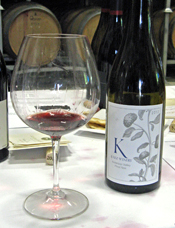 |
Knez 2012 Pinot Noir, Estate, Anderson Valley. Sourced from eight Pinot clones (from 60% Cerise Vineyard, 30% Demuth Vineyard, 10% Knez Vineyard), fermented with 50% whole clusters and aged in 25% new French oak. Medium-light color, featuring raspberry, tea leaf, and floral aromas. Medium-bodied with bright acidity and good structure, and firm tannins on the lingering finish, nice.
Knez 2011 Pinot Noir, Demuth Vineyard, Anderson Valley. About 30% whole-cluster fermentation. Medium-light ruby color, this had a more savory profile, with herbs, red fruits, and floral notes on the nose. More structured on the palate than the previous wine, with lively acidity and refined tannins, nice.
Knez 2011 Pinot Noir, Cerise Vineyard, Anderson Valley. From Martini, David Bruce, Pommard, Wädenswil (2A) and 777 clones, 50% whole-cluster fermentation. Medium-light color, with showing more spice along with forest floor, tea leaf, and black cherry aromas. Moderately rich mouthfeel, this finished with grippier tannins.
Comments: Proprietor Peter Knez purchased both Cerise and Demuth vineyards a few years ago, and in 2009 he planted the new Knez Vineyard between the two, all located high above Boonville. Cerise Vineyard was planted in 1995 with ten Pinot clones, while Demuth was planted in 1982, with Pommard and Wädenswil clones. Farming of the vineyards is transitioning to biodynamic. Anthony Filiberti is the winemaker. Knez continues to produce some standout wines.
Lichen Estate
Lichen NV Pinot Noir, “Solera,” Estate, Anderson Valley. From Martini, 2A, 667, and Pommard clones, from both 2011 and 2012 vintages. Lighter color, with earthy black cherry fruit and a resiny oak note. Medium-light weight with a brighter mouthfeel and moderate tannins.
Lichen 2012 Pinot Noir, Estate, Anderson Valley. From Martini, 2A, 667, and Pommard clones. Medium-light color, this had fruit-forward raspberry, along with spice, forest floor, and a touch of sweet oak. Medium-bodied and structured, with firm tannins on the finish – still needs time but has good potential.
Comments: The 2012 Pinot is Lichen’s first release. The winery was established by Doug Stewart, who had founded Breggo Cellars but sold that business a few years ago. The estate vineyard was planted in 2008 with densely-planted Pinot Noir and Pinot Gris, and is farmed organically. The “Solera” multi-vintage blend is expected to continue in the future.
Lazy Creek Vineyards
Lazy Creek 2013 Rosé of Pinot Noir, Estate, Anderson Valley. From fruit grown and picked specifically for Rosé. Light pink color, showing fresh strawberry, spice, and a floral note. Medium-light bodied with bright acidity, with a slight touch of tannin on the finish, nice.
Lazy Creek 2012 Pinot Noir, Estate, Anderson Valley. From Dijon and California heritage clones, aged in 33% new French oak. Medium color, featuring very upfront raspberry fruit along with notes of flowers, spice, and earth. Medium-light bodied with a lively mouthfeel and moderate tannins – an attractive Pinot for early drinking.
Comments: Dating back to 1973, Lazy Creek is one of Anderson Valley’s oldest wineries. Don and Rhonda Carano (of Ferrari-Carano in Dry Creek Valley) purchased Lazy Creek in 2008. Both of the wines I tasted at the event were quite good.
Lioco Wine Company
Lioco 2012 Pinot Noir, Klindt Vineyard, Anderson Valley. From 115, 667, 777, and Pommard clones, fermented with 30% whole clusters and aged in 20% new French oak. Medium-light color, with herbal/stemmy aromas plus red fruits and earth. Medium-bodied with a structured mouthfeel, bright acidity, and moderately grippy tannins, this is a promising wine that will take time to develop in the bottle.
Lioco 2011 Pinot Noir, Klindt Vineyard, Anderson Valley. From 115, 667, 777, and Pommard clones, fermented with 30% whole clusters and aged in 20% new French oak. Medium-light ruby, this showed riper and more upfront black cherry and plum fruit than the previous wine, along with spice and tea leaf notes. Somewhat richer mouthfeel, finishing with firm tannins.
Lioco 2012 Carignan, “Sativa,” Mendocino County. Sourced from two vineyards, fermented with 100% whole clusters and a submerged cap. Medium-light purple, featuring darker berry fruit, earth, and a touch of pepper on the nose. Medium-bodied with juicy acidity, this had a grippy tannic finish.
Comments: Established in 2005 by wine importer Matt Licklider and sommelier Kevin O'Connor, Lioco combines their last names. John Raytek of Ceritas took over as the Lioco winemaker in 2011. Klindt Vineyard is in the “Deep End” of Anderson Valley – the 2012 will be the last vintage from this vineyard for Lioco.
Maggy Hawk Wines
Maggy Hawk 2011 Pinot Noir, “Jolie,” Anderson Valley. Entirely from 115 clone. Medium-light color, this had shy aromas of red fruit along with earth, tea leaf, and undertones of vanilla/oak. Medium-bodied with firm tannins on the finish.
Maggy Hawk 2011 Pinot Noir, “Unforgettable,” Anderson Valley. Entirely from 667 clone. Medium ruby color, showing riper black cherry and plum on the nose, plus spice and sweet oak notes. Richer mouthfeel with a smoother texture and moderate tannins.
Comments: Maggy Hawk – another label from Jackson Family Wines – was launched with the 2007 vintage. Four Pinot bottlings are produced, each made entirely from a specific vineyard block and Pinot clone. Elizabeth Grant-Douglas is the winemaker.
Navarro Vineyards
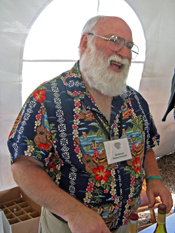 |
Navarro 2013 Rosé of Pinot Noir, Anderson Valley. From fruit picked especially for Rosé, kept on the skins for 5-6 hours before pressing to stainless steel and neutral puncheons. Light pink color, with fresh strawberry aromas along with herbal and floral notes. Lighter-bodied with bright acidity and a clean finish, nice.
Navarro 2012 Pinot Noir, “Méthode à l'Ancienne,” Anderson Valley. Medium-light ruby color, this displayed earth and forest floor upfront, with strawberry and rhubarb fruit in support. Medium-light bodied, with a lively mouthfeel and fairly mild tannins – this may pick up some weight with more bottle age.
Navarro 2012 Pinot Noir, “Deep End Blend,” Anderson Valley. From 114, 115, 667, and 777 clones, a barrel selection given longer aging in new and one-year old French oak. Medium color, showing a more fruit-forward character than the previous wine, with black cherry aromas along with earth, tea leaf and sweet oak. Medium-bodied with a smoother texture and moderate tannins.
Navarro 2011 Pinot Noir, “Méthode à l'Ancienne,” Anderson Valley. Lighter ruby color, this displayed strawberry and rhubarb plus forest floor, spice, and a touch of flowers. Medium-light weight on the palate with more structure than the previous two wines, finishing with firm tannins – could still use more time in the cellar but already nice.
Navarro 2010 Pinot Noir, “Méthode à l'Ancienne,” Anderson Valley. Medium-light color, with riper raspberry and black cherry fruit along with spice, tea leaf, and a touch of vanilla/oak. Medium-bodied with a moderately mouthfeel and refined tannins.
Comments: One of the earlier modern Anderson Valley wineries, Navarro was founded by Ted Bennett and Deborah Cahn. In 1974, they began planting their estate vineyard near Philo with Gewürztraminer, Pinot Noir, Riesling, Muscat, and Chardonnay. Winemaker Jim Klein has been at Navarro since 1992. The “Méthode à l'Ancienne” Pinots are typically aged in around 40% new oak. They tend to age very well and are fine values too. Bill Mitchell poured the Navarro wines at the tasting.
Nelson Hill Winery
Nelson Hill 2009 Pinot Noir, Deep End Vineyard, Anderson Valley. Sourced from 114, 115, and 777 clones, aged in 50% new oak. Lighter garnet color, with higher-toned red fruits, spice, and a resiny oak component. Medium-bodied with chewy tannins on the finish.
Comments: Nelson Hill was founded in 1999 by Greg and Barbara Hill, and is located in the Philo area. Deny Dudzik is both the vineyard manager and winemaker, and Philip Baxter consults on the winemaking.
Phillips Hill Winery
Phillips Hill 2011 Pinot Noir, “Two Terroirs,” Anderson Valley. Sourced from 70% Cerise Vineyard (115, 2A, Pommard clones) and 30% Ridley Vineyard (777 clone), some whole clusters, aged in 30% new oak. Medium-light garnet, displaying earthy and very smoky aromas along with black cherry fruit and spice. Medium weight on the palate with moderate tannins.
Comments: Founded in 2002 by vintner Toby Hill, the winery is on Greenwood Ridge west of Anderson Valley. The “Two Terroirs” bottling blends fruit from the hillside Cerise Vineyard and valley floor Ridley Vineyard. A Phillips Hill estate vineyard is in the planning stages.
Philo Ridge Vineyards
Philo Ridge 2010 Pinot Noir, Anderson Valley. From 115, 667, 777, 2A, and Pommard clones sourced from Ferrington and Philo Ridge vineyards, entirely destemmed, aged in 35% new oak. Medium-light garnet color, this was herbal and earthy, with red fruits and a touch of sweet oak in the background. Medium-bodied and structured, this had tingly acidity on the long pleasant finish.
Comments: Philo Ridge proprietors Fred Buonanno and Heather McKelvey purchased the vineyard and winery site of the old Christine Woods Winery in 1999, and Norman Kobler directed new plantings there in 2000. Heather is the winemaker, and the first Philo Ridge wines were released in 2004.
Roederer Estate
Roederer 2010 Pinot Noir, Estate, Anderson Valley. Sourced from 114, 115, 667, 777, and Pommard clones from several blocks of the estate vineyard, 100% destemmed. Medium-light color, with raspberry, spice, and vanilla/oak, as well as a mild but distinct barnyardy component. Medium weight in the mouth with moderately grippy tannins.
Comments: Roederer started developing its Anderson Valley estate vineyard in 1982 and produced its first sparkling wine from there in 1988. Arnaud Weyrich is the winemaker. Known primarily for their sparklers, Roederer also produces a small amount of still Pinot Noir.
Scharffenberger Cellars
Sharffenberger 2007 Pinot Noir, Anderson Valley. Includes fruit from six vineyards and nine Pinot clones, entirely destemmed, aged in 20% new oak. Lighter color, this had shy aromatics that revealed black cherry along with spice and earth. Medium-bodied with milder tannins on the finish.
Comments: John Scharffenberger established his eponymous label in 1981, and it’s been owned since 2004 by Maisons Marques & Domaines, which also owns Roederer Estate. Like Roederer, Scharffenberger is known for its sparkling wines but makes a little still Pinot Noir as well. Tex Sawyer has been the winemaker at Scharffenberger since 1989.
Toulouse Vineyards
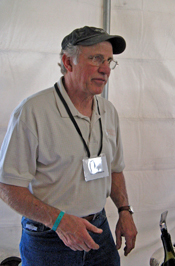 |
Toulouse 2012 Rosé of Pinot Noir, Estate, Anderson Valley. Picked early and whole-cluster pressed. Very light salmon/pink color, with earthy and savory aromas upfront and fresh strawberry notes in support. Medium-light weight on the palate, with fine acidity and a slight tannic bite on the finish, nice.
Toulouse 2011 Pinot Noir, Estate, Anderson Valley. Light garnet color, showing earth, mushroom, and forest floor notes along with spice and red fruits on the nose. Medium-bodied with juicy acidity and moderate tannins on the lively finish, nice.
Toulouse 2010 Pinot Noir, Estate, Anderson Valley. Medium-light ruby color, this featured upfront black cherry fruit plus spice, tea leaf, and notes of flowers and sweet oak in the background. Moderately rich mouthfeel with fairly mild tannins on the finish.
Comments: Vern and Maxine Boltz are the proprietors of Toulouse, and their first wine came from the 2002 vintage. Their estate vineyard is located just outside of Philo, and includes 115, 667, 777, and 2A Pinot clones. Vern was on hand to pour his wines at the event. This was a very good showing for the Toulouse wines.
Waits-Mast Family Cellars
Waits-Mast 2011 Pinot Noir, Wentzel Vineyard, Anderson Valley. Organically-farmed vineyard, from 114, 115, 667 and 777 clones. Medium-light color, with spice and black cherry upfront along with a floral note and vanilla/oak. Medium-bodied, this finished with milder tannins.
Waits-Mast 2012 Pinot Noir, Nash Mill Vineyard, Anderson Valley. From 115, 667 and Pommard clones. Slightly lighter color, with red fruits, earth, and a savory component on the nose. A bit bigger-bodied than the previous wine, finishing with firmer tannins.
Waits-Mast 2012 Pinot Noir, Deer Meadows Vineyard, Anderson Valley. From 115, 777, and Calera clones, entirely destemmed, aged in 25% new oak. Medium-light color, displaying intense raspberry fruit, tea leaf, and spice on the nose. Medium-bodied and more structured on the palate, with more grip on the finish – a promising wine that needs more time in the cellar.
Waits-Mast 2010 Pinot Noir, Londer Vineyard, Anderson Valley. Medium-light ruby color, this showed a savory quality upfront, plus black cherry, earth, and a stony mineral note. Medium-bodied with lively acidity and firm but refined tannins, nice.
Comments: Jennifer Waits & Brian Mast established their winery in 2005, and they focus solely on Pinot Noir, mostly sourced from Anderson Valley and nearby Comptche. Nash Mill Vineyard is owned by Husch’s Zac and Krista Robinson, while Deer Meadows, in the hills above Boonville, is owned by famed grower Rich Savoy. The wines are made in San Francisco, and use destemmed fruit that is fermented with native yeasts and typically aged in 25-30% new French oak. (Disclosure – I helped bottle the Waits-Mast 2012 Pinots)
Williams Selyem Winery
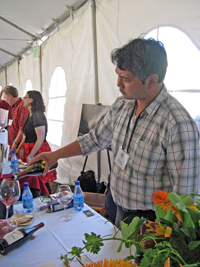 |
Williams Selyem 2011 Pinot Noir, Burt Williams’ Morning Dew Ranch, Anderson Valley. Mostly DRC selection, plus 115, 777, 23, and Rochioli, aged in 67% new oak. Medium-light color, featuring bright cherry, earth, and spice, with touches of flowers, tea leaf, and vanilla/oak. Medium-bodied with lively acidity and refined tannins, nice.
Williams Selyem 2011 Pinot Noir, Ferrington Vineyard, Anderson Valley. From 115, 667, 777, and Pommard clones, aged in 73% new oak. Medium-light color, the aromatics were less intense than the previous wine, and displayed a darker fruit profile along with more noticeable spice and oak components. A bit richer mouthfeel than the previous wine, with more structure and bigger tannins on the finish.
Comments: Though not located in Anderson Valley, Williams Selyem is one of the wineries that helped put Anderson Valley Pinot on the map with its Ferrington Vineyard bottling. More recently, it has produced Pinot from Morning Dew Ranch, planted in 2000 by winery founder Burt Williams. Williams Selyem winemaker Jeff Mangahas – who is taking over from longtime winemaker Bob Cabral this year – was on hand to pour the wines.
Wind Racer Wines
Wind Racer 2011 Pinot Noir, Anderson Valley. From five Pinot clones, destemmed, aged in 34% new oak. Medium-light color, this showed ripe black cherry fruit along with earth, spice, and a resiny oak component. Medium-bodied and structured, finishing with fairly grippy tannins.
Comments: Barbara Banke and Peggy Furth launched the Wind Racer label in 2006 – it’s part of the Jackson Family Wines portfolio. They produce Chardonnay and Pinot from Anderson Valley and Russian River Valley. This wine was poured at the Maggy Hawk Wines table.
Witching Stick Wines
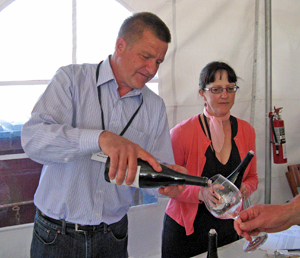 |
Witching Stick 2011 Pinot Noir, Cerise Vineyard, Anderson Valley. From 2A, 115, Martini, and Pommard clones, about 30% whole-cluster fermentation, aged in 40% new oak. Medium-light color, this had herbal and earthy aromas, along with red cherry and a touch of sweet oak. Medium weight on the palate with good structure and vibrant acidity, finishing with refined tannins, nice.
Witching Stick 2011 Pinot Noir, Gianoli Ranch, Mendocino Ridge. About 25% stem inclusion, aged in 70% new oak. Medium-light ruby, with bright red fruits, tea leaf, spice, and a savory quality on the nose. Bigger and more structured in the mouth than the previous wine, with a firmer tannic finish – still needs some time but should be very nice with more bottle age.
Witching Stick 2012 Pinot Noir, “Dowser’s Cuvée,” Anderson Valley. Sourced from Akin, Wiley, and Cerise vineyards in Anderson Valley and Gianoli Vineyard in Mendocino Ridge, aged in 27% new oak. Medium-light ruby color, featuring earth and forest floor aromas along with strawberry, tea leaf, and spice. Medium-bodied with juicy acidity and a savory character along with refined tannins on the finish, nice.
Witching Stick 2012 Pinot Noir, Wiley Vineyard, Anderson Valley. Medium color, this showed raspberry fruit, along with earth and herb notes. Medium weight in the mouth with fairly mild tannins.
Witching Stick 2012 Pinot Noir, Cerise Vineyard, Anderson Valley. Medium-light ruby color, displaying savory and herbal aromas upfront, along with black cherry, earth, and spice. Bigger and more structured, this finished with firm tannins that will need time to resolve.
Witching Stick 2012 Pinot Noir, Gianoli Ranch, Mendocino Ridge. Medium-light color, with aromas of earth and forest floor, red fruits, and a smoky, savory component. Medium-full bodied with plenty of structure, finishing with chewy tannins – another wine that should benefit from time in the cellar.
Comments: Witching Stick is the project of longtime Edmeades winemaker Van Williamson and partner Anne Fashauer. The first wines released from this new label were from the 2010 vintage, and the 2011 Cerise Pinot had been bottled in March. The wines undergo native primary and malolactic fermentations. Witching Stick very intriguing Pinots, which show lots of promise but deserve short- to medium-term aging to develop.
Woodenhead Vintners
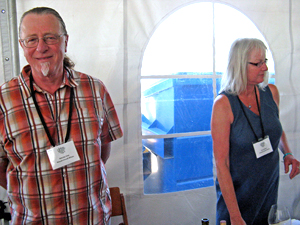 |
Woodenhead 2011 Pinot Noir, Mendocino Ridge. Sourced from Valenti Vineyard. Lighter color, showing slightly higher-toned raspberry fruit along with savory and earthy notes. Medium-bodied with moderate tannins on the finish.
Woodenhead 2009 Pinot Noir, Wiley Vineyard, Anderson Valley. From 28 year-old Pommard and Mt. Eden clone vines. Medium-light color, this showed red fruits and earth aromas, plus touches of forest floor, spice, and oak. Medium weight on the palate with good structure, finishing with moderate tannins, nice.
Woodenhead 2010 Pinot Noir, Wiley Vineyard, Anderson Valley. Slightly lighter color, with bigger earth and forest floor components along with black cherry and tea leaf. Bigger and more structured in the mouth, this finished with grippier tannins.
Comments: Woodenhead proprietors Nick Stez and Zina Bower poured their wines at the tasting. Nick worked with Burt Williams at Williams Selyem for 17 years before starting his own label in the late 1990s. Woodenhead specializes in Pinot Noir and Zinfandel from a variety of vineyard sources.
|


